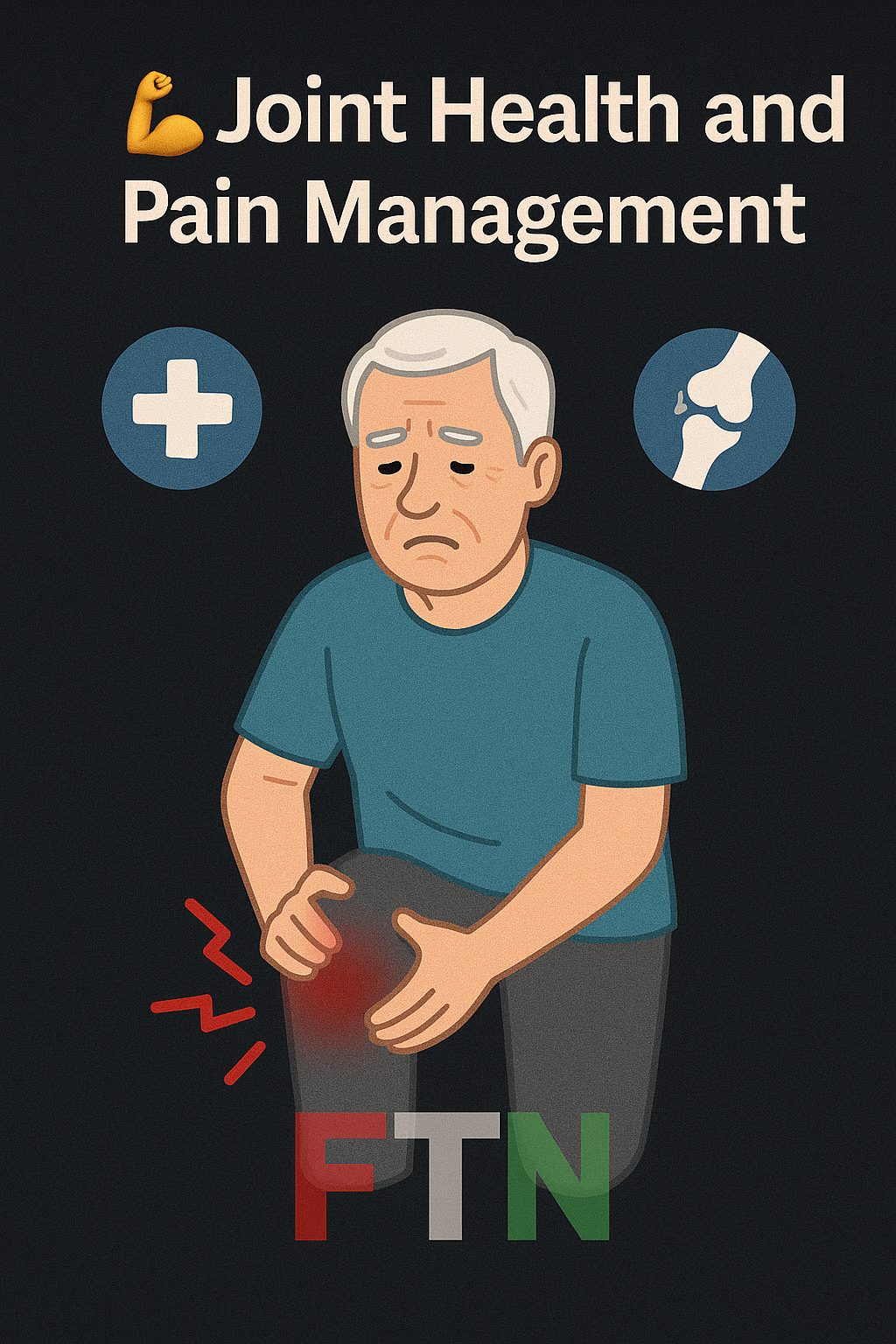As we age, maintaining joint health in seniors becomes essential—not just for comfort, but for preserving independence, mobility, and overall quality of life. Our joints bear the impact of every movement, from daily tasks like bending or standing to simple pleasures like walking in the park. Over time, wear and tear can lead to stiffness, discomfort, and reduced mobility.
In this guide, we’ll explore the most common joint issues affecting older adults and offer practical advice for pain management: tips for comfort and mobility that really make a difference. Whether you’re navigating these challenges yourself or supporting an aging loved one, you’ll find simple, effective strategies to ease discomfort and move with greater confidence.
🧠 Understanding Joint Health in Older Adults
Joint health directly influences a senior’s ability to move freely, remain active, and live independently. As we grow older, natural changes in joint structure—such as reduced cartilage, decreased flexibility, and lower synovial fluid levels—make the joints more vulnerable to wear and tear.
The most common condition is osteoarthritis, where the protective cartilage between bones breaks down over time. This causes pain, stiffness, and swelling, often in the knees, hips, and hands. On the other hand, rheumatoid arthritis is an autoimmune disease that causes chronic inflammation and joint deformity if not treated early.
Other joint issues like bursitis, tendinitis, and gout also affect many seniors, making even basic movements painful. These conditions, combined with factors like inactivity, obesity, and previous injuries, can reduce quality of life if not addressed.
The good news? With the right lifestyle changes and support, seniors can greatly improve joint health and maintain the freedom to move with confidence.
🔍 Common Joint Problems in Seniors
Here are some of the most frequent joint issues faced by older adults:
- Osteoarthritis (OA): The most widespread joint condition in seniors. It results from the natural breakdown of cartilage, leading to joint stiffness, swelling, and pain—especially after rest or prolonged activity.
- Rheumatoid Arthritis (RA): Unlike OA, this autoimmune condition causes the body to attack its own joints. It’s usually symmetrical, affecting both sides of the body (e.g., both hands or both knees) and may come with fatigue or weight loss.
- Gout: Caused by a buildup of uric acid crystals, typically affecting the big toe. Sudden and severe pain, redness, and swelling are hallmarks of this condition.
- Psoriatic Arthritis: Linked to psoriasis, this condition leads to joint inflammation, often accompanied by skin flare-ups.
Recognizing symptoms early—like morning stiffness, swelling, or reduced flexibility—can help seniors seek timely medical intervention and prevent further joint damage.
🥗 The Role of Nutrition in Joint Comfort
What you eat can impact how your joints feel. An anti-inflammatory diet is one of the most powerful tools for maintaining joint health naturally.
- Omega-3 Fatty Acids: Found in salmon, sardines, walnuts, and flaxseeds, omega-3s help reduce inflammation and joint stiffness.
- Vitamin D: Vital for calcium absorption and bone strength. Seniors can get it from sunlight, fortified dairy, and fatty fish.
- Vitamin C: Supports collagen production and fights oxidative stress. Found in citrus fruits, strawberries, bell peppers, and leafy greens.
- Antioxidants: Berries, nuts, and dark chocolate help neutralize free radicals that can damage joints.
A balanced diet rich in whole foods, lean proteins, vegetables, and healthy fats can improve joint function while supporting overall health.
🏃♀️ Safe Exercise for Joint Support
Contrary to popular belief, staying still makes joint pain worse. Movement is essential for joint lubrication, muscle support, and flexibility.
Here are the best types of exercises for seniors:
- Low-impact aerobic exercise: Walking, swimming, and cycling improve circulation and strengthen the heart without stressing the joints.
- Stretching and flexibility training: Gentle yoga or stretching routines reduce stiffness and increase your range of motion.
- Strength training: Light resistance bands or dumbbells strengthen the muscles that support joints, helping relieve pressure and pain.
- Balance-focused workouts: Tai chi and chair yoga can reduce fall risks while boosting joint stability.
It’s best to start slow and increase intensity gradually. Consulting a healthcare provider or physical therapist before starting any routine ensures safety and effectiveness.
💊 Pain Relief Strategies that Work
Managing joint pain requires a mix of approaches, tailored to each individual’s needs and health status:
- Over-the-counter (OTC) medications like ibuprofen or acetaminophen can reduce inflammation and pain. Always check with your doctor before starting any new medication.
- Topical creams and gels with menthol or capsaicin provide localized relief and are easy to apply.
- Heat and cold therapy: A warm compress can loosen stiff joints, while a cold pack helps reduce swelling and numb pain.
- Mindfulness and relaxation: Deep breathing, meditation, or guided imagery can help distract the mind from pain and reduce stress levels.
- Physical therapy: A therapist can tailor exercises that target joint strength and flexibility, improving function and comfort.
Consistency is key. A combination of these methods is often more effective than relying on a single solution.
🦯 Mobility Aids That Make a Difference
Assistive devices offer vital support for seniors with joint discomfort, helping them move more easily and avoid injuries.
Popular options include:
- Canes: Great for those needing minimal support, especially for one-sided pain.
- Walkers: Offer more stability and often come with seats for resting.
- Joint braces and orthotics: Help support specific joints like knees or ankles during activity.
- Grab bars: Installed in bathrooms or stairways for added balance and safety.
Always consult a healthcare professional to find the right fit and function for your needs.
🛋️ Home Modifications for Safety and Comfort
A few simple changes at home can go a long way in preventing joint strain and reducing fall risks:
- Remove clutter and loose rugs that could cause trips.
- Install grab bars in high-risk areas like bathrooms.
- Use non-slip mats in the kitchen and bathroom.
- Rearrange furniture to create wide, open pathways.
- Improve lighting to help with visibility, especially at night.
These adjustments promote independence and help seniors feel more secure at home.
⏳ Knowing When to Seek Help
While mild joint discomfort is common, certain symptoms require medical attention:
- Persistent or worsening pain
- Redness, swelling, or warmth in a joint
- Difficulty moving or using a joint normally
- Fatigue, fever, or unexplained weight loss
Seeing a doctor early can prevent more serious complications. Rheumatologists and physical therapists offer specialized care and treatment plans.
💬 Real-Life Inspiration: Stories of Strength
Many seniors have successfully regained control over their joint health with lifestyle changes and determination.
Take Mrs. Linda, age 82, who struggled with knee osteoarthritis. Through a combination of aquatic exercises, a Mediterranean diet, and gentle yoga, she reduced her pain and increased her energy.
Or Mr. James, 75, who used to avoid walks due to chronic pain. After working with a therapist and using a walker, he now walks every morning with his neighbors.
Their stories prove that improvement is always possible—no matter your age.
✅ Final Thoughts
Joint health is vital for aging with grace, independence, and vitality. While pain and stiffness may be part of growing older, they don’t have to define it. With smart strategies—like balanced nutrition, safe exercise, pain management tools, and supportive environments—seniors can move through life more comfortably and confidently.
Every step counts. And with the right care and consistency, better mobility is within reach. 🧡
🔍 Video Review:
Title: Exercises to Reduce Joint Pain – Dr. Teeter (Norton Orthopedic Institute)
✅ What’s Great About This Video
- Professional Medical Authority
Hosted by a certified orthopedic expert, adding credibility and trust — ideal for seniors looking for reliable advice. - Clear and Calm Delivery
The instructor explains joint-friendly movements in a calm tone, making it easy to follow for older adults. - Practical Demonstrations
Real-time demos with slow transitions make it perfect for seniors, especially those who need extra time or use assistive devices. - Short and Focused
It’s under 10 minutes — a great entry point for beginners who may feel overwhelmed by longer routines. - Targeted for Joint Pain
The exercises specifically address joint stiffness, range of motion, and pain relief, which matches the exact purpose of your article.
🔧 Suggestions & Improvements for Better Viewer Experience
These suggestions are ideal if you’re embedding the video in a blog, recommending it, or even contacting the creator.
- Add On-Screen Exercise Names or Timers
This would help seniors better understand the structure of the session.
Adding a simple text overlay like “Shoulder Rolls – 30 secs” keeps users engaged and informed.
- More Verbal Cues
Occasionally, the video relies too much on visual demonstration.
Adding more verbal reminders, such as “Keep your spine straight” or “Breathe deeply,” would increase accessibility.
- Include Warm-Up/Cool-Down Instructions
The video jumps into stretches fairly quickly.
It would benefit from a 30-second warm-up suggestion or post-exercise cool-down advice — even just a recommendation at the start or end.
- Add Captions or Subtitles
Greatly helpful for:
Seniors with hearing loss.
Non-native English speakers.
Mobile viewers watching without sound.
- Improve the Thumbnail for Better Click-Through
A thumbnail with bold text like:
“Ease Joint Pain with Simple Movements – Doctor Approved”
would be more eye-catching for blog readers and search users.
✍️ Optional Caption for Your Article (to introduce the video):
💡 Looking for expert-backed exercises to ease joint pain? Watch this short routine by Dr. Teeter to improve mobility and reduce stiffness—all from the comfort of home

